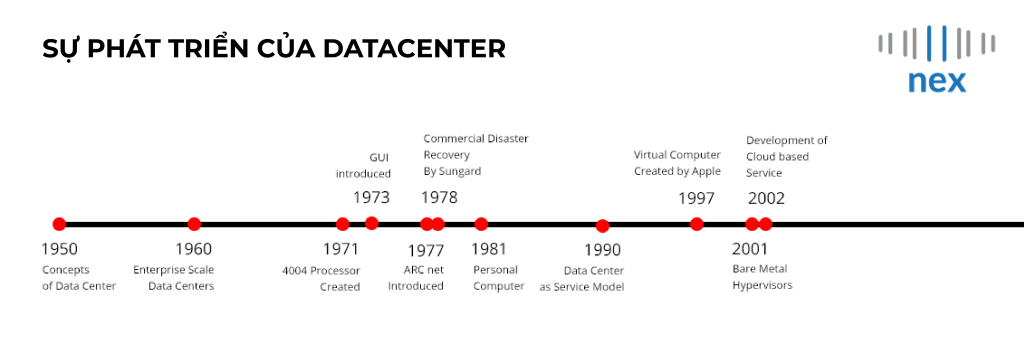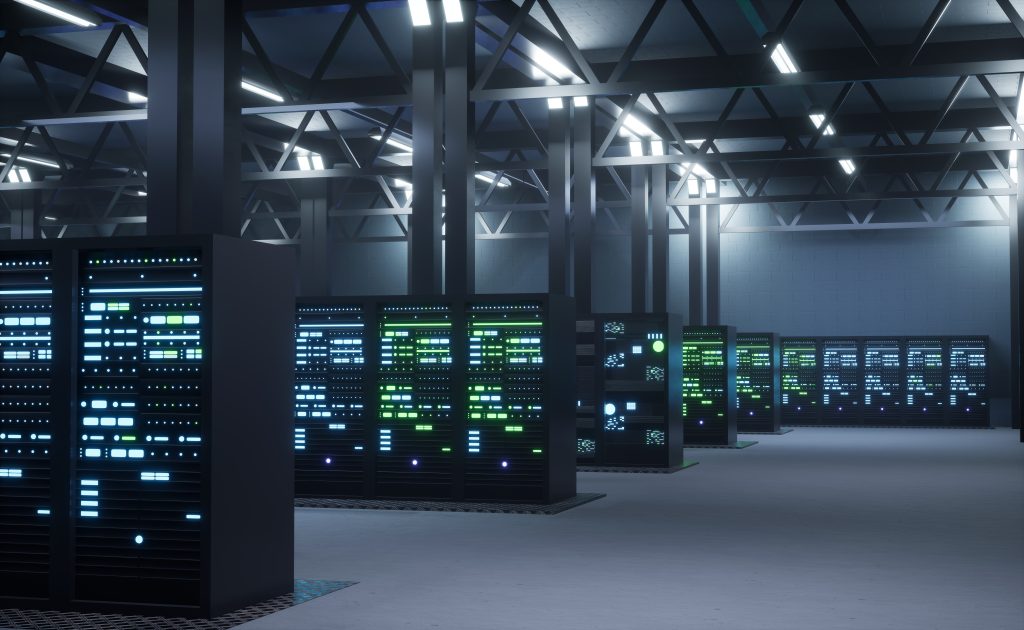What is a Data Center?
Data Centers are giant groups of networked servers that are connected together. These connected computers can and often do empower organizations to run applications, provide them with networking capabilities to connect employees and resources, and provide storage capabilities to process data.

A data center is a special facility that stores and processes data for an organization or business. The concept of a data center first appeared in the 1940s, when computer hard drives presented many complex problems in operation and maintenance. At that time, computers required complex connections between devices and consumed a large amount of electricity, requiring frequent cooling systems. To solve this problem, companies concentrated hardware devices in a separate space – the data center.
Over time, hardware technology has developed strongly, helping to reduce the size and power requirements of devices, however, the requirements for security, stability and scalability of information technology systems are increasingly high. Today's data centers not only ensure stable operations but also help businesses grow sustainably and be more flexible in handling large workloads.
Origin and Evolution of Data Centers
The origins of the first data centers can be traced back to the 1940s and the existence of early computer systems, such as the Electronic Numerical Integrator and Computer (Electronic Numerical Integrator and Computer) , or ENIAC. These early machines, used by the military, were complex to maintain and operate. They required dedicated computer rooms with racks, cable trays, cooling mechanisms, and restricted access to accommodate all the equipment and implement appropriate security measures.

However, it was not until the 1990s, when IT operations began to expand and cheap networking equipment became widely available, that the term data center was first used. It was possible to store all the necessary servers of a company in a single room in the company. These dedicated computer rooms were dubbed data centers in organizations, and the term gained a lot of traction.
Around the time of the dot-com bubble in the late 1990s, the need for internet speed and constant internet presence for companies required larger facilities to house the large amounts of networking equipment needed. It was at this time that data centers became popular and began to resemble the ones described above.
How does a Data Center work?
A data center facility allows an organization to pool its resources and infrastructure to process, store, and communicate data, including:
- Systems for storing, sharing, accessing and processing data across the organization;
- Physical infrastructure to support data processing and data communications;
- Amenities such as cooling, power, network security access and uninterruptible power supplies (UPSes).

Bringing all of these resources together in one data center allows organizations to do the following:
- Protect proprietary systems and data;
- Centralize IT and data processing staff, contractors and vendors;
- Centralize IT and data processing staff, contractors and vendors;
Why is Data Center important?
Data centers play an essential role in the growth and maintenance of many organizations and businesses. Important functions of data centers include:
Data Storage and Management: Data centers provide a secure and efficient environment for storing and managing large volumes of data. Ensuring data is always available and protected from loss or damage.
Supporting business continuity: With redundant systems and high fault tolerance, the data center ensures uninterrupted business operations, even in the event of a failure. This is especially important for online services and applications that require high reliability.
Increased performance and scalability: Data centers help businesses quickly expand their IT systems to meet growing needs without facing infrastructure issues. This scalability helps optimize operations and minimize problems when handling large workloads.
Data Security: With the rise of external threats such as cyber attacks and malware, data centers employ advanced security measures to protect business data and systems from potential risks.
Cost optimization: Using a data center helps businesses save on investment and maintenance costs for information technology infrastructure, thereby focusing resources on core activities and developing long-term strategies.
Supporting New Application Development: With the ability to provide powerful computing resources, data centers are an important platform for developing and deploying new applications and services such as the Internet of Things (IoT), artificial intelligence (AI), machine learning, and other advanced technology solutions.
Key Components of a Data Center
A data center is more than just a space that houses servers, it also includes many important components that help ensure the system operates efficiently and securely:

Information Security System: To protect data from external threats, the data center uses security measures such as security monitoring, patch management, and security vulnerability assessment tools.
Infrastructure: Including electrical systems, backup power sources, fire protection systems, air conditioning, and security monitoring systems to ensure that all activities of the center take place continuously and stably.
Network system: Includes devices such as switches, routers, firewalls, which help manage data flow, protect the network system and connect between devices.
Computing and storage systems: Servers, virtualization software, data storage and backup systems play a crucial role in processing and storing massive amounts of data.
With the constant development of technology, Data Centers are facing many changes and new trends:

Digital Transformation and Cloud Computing: Data centers are increasingly playing an important role in supporting cloud services and SaaS (Software as a Service) solutions. Enterprises are turning to cloud computing to optimize costs and improve system scalability.
AI and Automation: The use of artificial intelligence and automation tools to monitor, maintain, and optimize performance is a prominent trend in modern data centers.
Security and Cyber Attack Prevention: With the increasing risk of cyber attacks, modern data centers focus not only on physical security but also on information security solutions and cyber attack prevention.
Energy Efficiency: Data centers are increasingly moving towards energy efficiency and sustainability solutions, such as renewable energy applications to minimize environmental impact.
